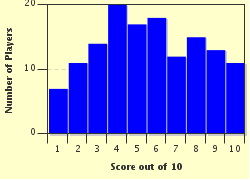Quiz Answer Key and Fun Facts
1. A former prison and one of 150 execution sites in the country, in which Asian capital is the "Tuol Sleng Genocide Museum" now an unusual tourist attraction?
2. The market town of Kousseri in northern Cameroon stands on the west bank of the Chari River where it joins the Logone River. Directly across the river and connected by a bridge stands the port of N'Djamena, the largest city in which African country?
3. Although Santiago is the executive and judicial capital of Chile, the country's parliament (Congress) meets in which port city, 70 miles to the northwest?
4. The colours yellow, green and red represented the Pan-Africanist movement during the fight for independence from European colonization, and today the flags of many African nations carry them some design or other. Which of these countries does NOT have a flag consisting of these three colours?
5. Prior to the kick-off of all matches at major football (soccer) tournaments you will hear players and fans joining in with rousing renditions of their country's national anthem. Which country's players are unable to sing along?
6. The Latin motto 'A Mari Usque Ad Mare' ("From Sea to Sea") appears on the official coat of arms of which Commonwealth country?
7. Which island chain (consisting of 14 large volcanic islands and 55 smaller ones) includes the Fox Islands, the Islands of Four Mountains, the Andreanof Islands, the Rat Islands and the Near (or Sasignan) Islands?
8. South America's largest country, Brazil, shares land borders with ten of the continent's twelve other countries. With which of those countries does Brazil have its longest border, stretching more than 2,000 miles?
9. Guaranteed by the French Treasury, the Central African Franc and the West African Franc are the principal currencies in a total of fourteen countries, most of them former French colonies. Which African former French colony left this cosy union in 1973 and replaced it with the ouguiya, one of only two non-decimal currencies in the world?
10. Situated near the Sagami River on the edge of the foothills of the Tanzawa Mountains, Camp Zama is the primary U.S. military facility in which country?
Source: Author
EnglishJedi
This quiz was reviewed by FunTrivia editor
stedman before going online.
Any errors found in FunTrivia content are routinely corrected through our feedback system.


